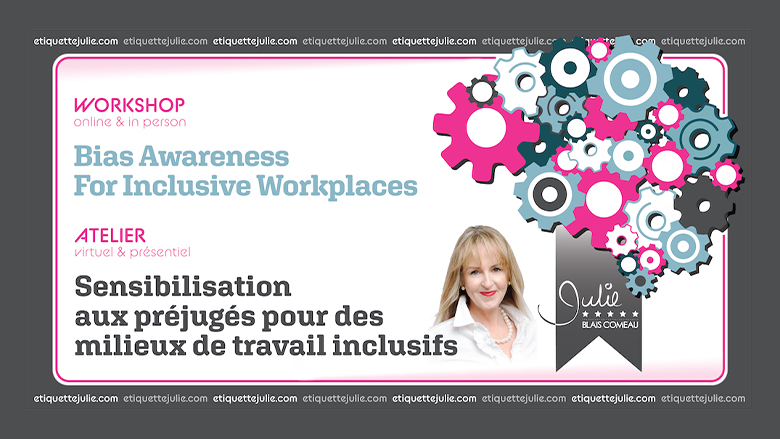Bias awareness for an inclusive workplace

I am biased, you are biased, etc. You are biased, you have prejudices. Surprised? Shocked? Intrigued? I know, I know. You love everyone, in all colours and shapes, equally. But the fact remains, even if you are a professional who values diversity and inclusion, you are biased and you have prejudices. Allow me to reassure you, to be biased, to have prejudices, is perfectly human. I do too.
I– COGNITIVE BIAS IS NOT FINAL
Cognitive bias is your interpretation of what you are experiencing. You validate what you see against the reality. Anchored in your values, your beliefs, your culture, your education, your learnings, your experiences, your interactions, etc., you distort the meaning of a situation or an action, according to your perception. Your personal filter first searches for similarities to secure and classify according to what you know. This monovision justifies and legitimizes your decisions. These decrees dictate your actions and your words. This bias is emotional and not reasoned. It does not take into account the totality of the reality and all of its facets. It is not impartial. Often unconscious, cognitive bias is reactive. It responds to a stimulus interpreted by you, for you, and proposes reactions, selected from your inventory.
Prejudice often has a bad reputation, but beware, it is not always bad. These impressions that capture what you are going through motivate your actions. Through the years, if not milleniums, these instinctive judgments have allowed the human race to survive. These beneficial prejudices are activated when you are faced with danger. In this state of flight or fight, at the speed of light, your mind analyzes to figure out how to defend yourself or what is your best exit strategy. Like your computer, your brain then searches your repertoire for similar situations to safely repeat your past behaviour. Quickly, based on the already existing information, compartmentalized and saved by you, you decide to stay if you know the situation or to leave, retrieve, if what you are experiencing has not been lived. Your judgment is based on what you know.
When what you are experiencing is not part of your catalogue, denial may follow. This individual interpretation excludes what is unfamiliar. You can paralyze, be afraid, or refuse to participate. From these basic instinctive and survival behaviours are born exclusions.
At work, during a recruitment process, certain elements can trigger judgments. For example, you may associate certain tasks with certain groups of people. Or, when you receive resumes and information is missing, you fill in the gaps using different assumptions. Aware of these automatic screening mechanisms, may organizations use very structured selection interview grid, with specific criteria, to ensure that equal opportunities are given to all applicants.
Interesting fact; to avoid biases, symphony orchestras conduct blind auditions. They don’t see the candidates. They only listen to the musicians. How could you use this technique within your company…?
II– GENERALIZATIONS AND STEREOTYPES
All stereotypes come from generalizations. Often negative, stereotypes of certain groups of people are based on your experiences with them, comments received by people you trust about them, and messages conveyed by your favorite media sources of them. These prejudices “label” people without taking into account their characteristics.
Conversely, generalizations are presented as helpful. They put into context the assertions made about the characteristics and behaviours of individuals, within the same community. Stereotypes judge instead of describing. Generalizations of common behaviours within a group are typically positive and helpful observations.
“Human resources professionals are not very transparent” is a stereotype. While “To maintain confidentiality, human resources professionals are discreet and reserved”.
Often people do not hesitate to mention their favourable biases. But the fact remains that stereotypes and generalizations can both be true or false. “All women are stylish” can be flattering to women without being true. The problem is that stereotypes and generalizations bias instead of validate the current experience with the person or the people you are interacting with. Stereotypes encourage prejudice and can easily lead to discrimination.
III– IMPLICIT VERSUS EXPLICIT
Implicit or explicit, unconscious or conscious, biases affect your words, your actions and your gestures. They can be seen as segregationist or exclusive. Rolling your eyes, “them in HR,” looking at your cell phone when someone is speaking, are all behaviours that may be interpreted as exclusive.
When a bias is implicit, it is unspecified. The “why” is not expressed. An implicit bias is devious and difficult to identify. Since an implicit bias is not stated, it is often unconscious and above all difficult to prove.
As for the explicit bias, it explains the finding, it details the reasoning, the judgment. In situations of crisis and anxiety, in the heat of the moment, explicit biases come out much more quickly and are heralded or even desperately shouted out. Everyone present becomes aware of the existence of the bias. Heard, prejudices can be more easily addressed, questioned, investigated or denounced.
IV– IDENTIFY YOUR PREJUDICES
At this point, I’m sure you’re looking backwards into the rear-view mirror of how you could have been perceived as prejudiced. Like me during my research, you are probably horrified by past words or actions that you now regret. This recognition of your prejudices, initiated by this reading, is a good awareness. Continue your evolution with the Implicit Associations Test from Harvard University. You will have the choice of taking the test to discover your possible implicit associations on: gender, skin colour, age, country, sexual orientation, race or weight. This awareness can be used as an icebreaker activity for one of your meetings, especially for those of the “Diversity and Inclusion for a Healthy and Balanced Workplace” committee.
V- HOW TO COUNTER PREJUDICE
Admit that you are human; that you are biased.
Recognize that your lens is tinted with your colour. Investigate your impulses before you act. Approach these motivations with curiosity. Observe around you as you speak and move subtly, even slyly. Squints, shoulders backing up, forced smiles? Ask to understand before being understood. Be empathetic. Change your perspective. Observe the interaction from the outside in. Learn.
Develop your cultural curiosity and recognize diversity at work.
Socialize with people that are not like you, to broaden your range of experiences, habits and knowledge. Learn about their customs. Use your senses to develop your empathy. Cook with their spices. Dance to their music. Learn phrases in their language and use them. As the holiday season is approaching, inquire about your team members’ traditions. In addition to taking the above test, start or end a meeting by inviting participants to state how they are different or similar. “I am __________, but I am not __________”, or “I am like you __________, but different in __________”.
When you witness discrimination, focus on the facts and validate them.
When you hear negatively biased comments, confirm them. Like the fair reporter, while remaining objective, without pointing fingers, do not let the comment slip by. “Silence is an agreement”. Interrupt to confirm or to ignite awareness, “Did I hear you say …? “” Let’s rewind the tape. Could you please repeat what you just said.” “You know that kind of comment could be interpreted as discriminatory.” As needed and according to your role, document, report and discipline.
Collaborate with a specialist.
Whether it is a virtual interactive conference, an online workshop or a debriefing session after a psychometric test, the contribution of a specialized collaborator will add seriousness to your intentions. At your service with my brand-new workshop Bias Awareness for an Inclusive Workplace. Insert link
CONCLUSION
Since the tragic and much publicized deaths of George Floyd, Joyce Echaquan and others belonging to visible minorities, news sources are shining light on the dark side of the prejudices which led the responders to cause death. Aware of these inequities we can stop discriminatory words as well as exclusive gestures. You have the power to educate, so everyone can have the same chance to thrive at work.
Providing an inclusive and diverse workplace does not mean inviting everyone to the dance. Providing an inclusive and diverse workplace is about making sure that everyone will be asked to dance.
Published in The référence l’Ordre des conseillers en ressources humaines du Québec November 17 2020 (c) Julie Blais Comeau




